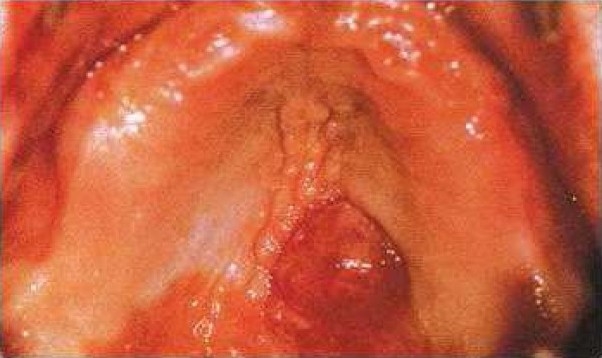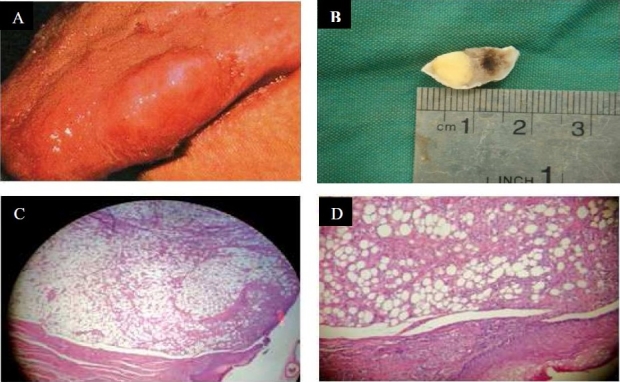Abstract
Lipoma is a common tumor of soft tissue. Its location on the oral mucosa is rare, representing 1% to 5% of benign oral tumors although it is the most mesenchymal tumor of the trunk and proximal por-tions of extremities. Lipoma of the oral cavity may occur in any region. The buccal mucosa, tongue, and floor of the mouth are among the common locations. The clinical presentation is typically as an asymptomatic yellowish mass. The overlying epithelium is intact, and superficial blood vessels are usually evident over the tumor. Other benign connective tissue lesions such as granular cell tumor, neurofibroma, traumatic fibroma and salivary gland lesions (mucocele and mixed tumor) might be included in differential diagnosis. We present two cases of oral lipoma in unusual locations: one in junction of soft and hard palate and the other in tongue. Both were rare in the literature.
Keywords: Differential diagnosis, Lipoma, Pathology
Introduction
Lipomas are common tumors in the human body,1,2 but are less frequent in the oral cavity, comprising no more than 1-5% of all neoplasms.2–4 They commonly present as slow growing asymptomatic lesions with a characteristic yellowish color and soft, doughy feel in the buccal mucosa, floor of the mouth and tongue, in the fourth and fifth decades and generally with no gender predilection. Some studies, however, have shown a male predominance.4–6
Half of oral lipomas are in the cheek and the remainders were found in the tongue, floor of the mouth, lips, palate and gingiva.7 They are benign mesenchymal neoplasms composed of fat cells usually surrounded by a thin fibrous capsule.8 The size of tumor depends on the location but rarely exceeds 25 mm in diameter.9 Lipomas are usually asymptomatic until they grow to large size and may interfere with speaking and mastication.1,10 Although malignant counterpart of this tumor ,liposarcoma, is another common soft tissue neoplasm, but its occurrence in oral cavity is rare.11
Case Report
Two cases of lipoma of oral cavity were referred to the department of oral and maxillofacial pathology. In one case, the patient was a 50 year-old man who had lipoma of the palate. It was a soft sessile mass, 1.5 cm in diameter and it was between soft and hard palate (Figure 1).The patient reported two-month dysphagia. On histologic examination, the tumor was composed of mature lipocytes and was well-circumscribed and demonstrated a thin fibrous capsule. A distinct lobular arrangement of the cells was seen.
Figure 1.

Soft, sessile mass between soft and posterior hard palate, in a 50 year-old man
In other case, the patient was a 63 year-old man. He was healthy with no history of smoking. The tumor was a submucosal mass under epider-mis on the lateral border of the dorsal part of the tongue (Figure 2A). The lesion was 1 cm in diame-ter (Figure 2B).
Figure 2.

(A) Submucosal mass on the lateral border of the dorsal part of the tongue. (B) Gross picture of lipoma on the dorsal part of the tongue. (C) Lobulated mass with fibrosis capsule (H & E staining, original magnification X100). (D) Mature fat cells (H & E staining, original magnification X400)
It had no pain and lasted for 5 years. The Patient's chief complaint was difficult mastication. On histology, there was a lobulated mass with well-defined margins. Mature fat cells were seen clearly (Figures 2C and 2D.
Discussion
To our knowledge, occurrence of lipoma in junction of hard and soft palate mucosa has not been reported in the literature and also tongue is not a common site for this neoplasm.
Lipomas are the most common mesenchymal tumors especially in trunk and proximal portions of the extremities but they are rare tumors of oral cavity.1–4 They present as slow growing asymptomatic lesions with yellowish color and soft, doughy feel, generally with no gender predilection. Other connective tissue lesions such as granular cell tumor, neurofibroma, traumatic fibroma, and salivary gland lesions (mucocele and mixed tumor) might be included in the differential diagnosis.4–6
Lipomas are well-defined in clinical examination, CT scan and MRI.12 In some cases, they can present as fluctuant nodules.13 Some other lesions should be considered in the differential diagnosis such as lymphoepithelial cysts, epidermoid and dermoid cysts.14
They may present as solitary or multiple lesions.1,2 Their mean size is 20 mm.15 Microscopically, it is difficult to differentiate between lipoma and normal adipose tissue.5 The microscopic appearance of a circumscribed but not encapsulated aggregate of mature adipocytes with large clear cytoplasm in the absence of vascularity is diagnostic of a classical lipoma.5 Microscopically, differential diagnoses are angiolipoma, liposarcoma and normal soft fatty tissue.7 Lipomas of oral cavity are rare, 50% of them are in buccal mucosa and less common sites are tongue, floor of the mouth and lips. Lipoma of palate was rare in the literature and most of them are developmental lesions but true neoplasms of fat cells are rare in this place.16,17
Surgical excision is the main treatment. Recurrence is reduced by wide surgical excision.2 Infiltrating lipomas are difficult to extirpate and are liable to recurrence.1,5
References
- 1.Chidzonga MM, Mahomva L, Marimo C. Gigantic tongue lipoma: a case report. Med Oral Patol Oral Cir Bucal. 2006;11(5):E437–9. [PubMed] [Google Scholar]
- 2.Del Castillo Pardo de Vera JL, Cebrian Carretero JL, Gomez GE. Chronic lingual ulceration caused by lipoma of the oral cavity.Case report. Med Oral. 2004;9(2):166. [PubMed] [Google Scholar]
- 3.Trandafir D, Gogalniceanu D, Trandafir V, Caruntu ID. [Lipomas of the oral cavity--a retrospective study] Rev Med Chir Soc Med Nat Iasi. 2007;111(3):754–8. [PubMed] [Google Scholar]
- 4.Bandeca MC, de Padua JM, Nadalin MR, Ozorio JE, Silva-Sousa YT, Cruz Perez DE. Oral soft tissue lipomas: a case series. J Can Dent Assoc. 2007;73(5):431–4. [PubMed] [Google Scholar]
- 5.Adoga AA, Nimkur TL, Manasseh AN, Echejoh GO. Buccal soft tissue lipoma in an adult Nigerian: a case report and literature review. J Med Case Reports. 2008;2:382. doi: 10.1186/1752-1947-2-382. [DOI] [PMC free article] [PubMed] [Google Scholar]
- 6.Lawoyin JO, Akande OO, Kolude B, Agbaje JO. Lipoma of the oral cavity: clinicopathological review of seven cases from Ibadan. Niger J Med. 2001;10(4):189–91. [PubMed] [Google Scholar]
- 7.Vindenes H. Lipomas of the oral cavity. Int J Oral Surg. 1978;7(3):162–6. doi: 10.1016/s0300-9785(78)80019-2. [DOI] [PubMed] [Google Scholar]
- 8.Fregnani ER, Pires FR, Falzoni R, Lopes MA, Vargas PA. Lipomas of the oral cavity: clinical findings, histological classification and proliferative activity of 46 cases. Int J Oral Maxillofac Surg. 2003;32(1):49–53. doi: 10.1054/ijom.2002.0317. [DOI] [PubMed] [Google Scholar]
- 9.Rapidis AD. Lipoma of the oral cavity. Int J Oral Surg. 1982;11(1):30–5. doi: 10.1016/s0300-9785(82)80045-8. [DOI] [PubMed] [Google Scholar]
- 10.Keskin G, Ustundag E, Ercin C. Multiple infiltrating lipomas of the tongue. J Laryngol Otol. 2002;116(5):395–7. doi: 10.1258/0022215021910906. [DOI] [PubMed] [Google Scholar]
- 11.Favia G, Maiorano E, Orsini G, Piattelli A. Myxoid liposarcoma of the oral cavity with involvement of the periodontal tissues. J Clin Periodontol. 2001;28(2):109–12. doi: 10.1034/j.1600-051x.2001.028002109.x. [DOI] [PubMed] [Google Scholar]
- 12.Sakai T, Iida S, Kishino M, Okura M, Kogo M. Sialolipoma of the hard palate. J Oral Pathol Med. 2006;35(6):376–8. doi: 10.1111/j.1600-0714.2006.00409.x. [DOI] [PubMed] [Google Scholar]
- 13.Tan MS, Singh B. Difficulties in diagnosing lesions in the floor of the mouth-report of two rare cases. Ann Acad Med Singapore. 2004;33(Suppl 4):72–6. [PubMed] [Google Scholar]
- 14.Anavi Y, Gross M, Calderon S. Disturbed lower denture stability due to lipoma in the floor of the mouth. J Oral Rehabil. 1995;22(1):83–5. doi: 10.1111/j.1365-2842.1995.tb00215.x. [DOI] [PubMed] [Google Scholar]
- 15.Darling M, Thompson I, Schneider J. Spindle cell lipoma of the alveolar mucosa: a case report. Oral Surg Oral Med Oral Pathol Oral Radiol Endod. 2002;93(2):171–3. doi: 10.1067/moe.2002.120520. [DOI] [PubMed] [Google Scholar]
- 16.Miles DA, Langlais RP, Aufdemorte TB, Glass BJ. Lipoma of the soft palate. Oral Surg Oral Med Oral Pathol. 1984;57(1):77–80. doi: 10.1016/0030-4220(84)90266-4. [DOI] [PubMed] [Google Scholar]
- 17.Ebling H, Wagner JE. Lipoma of the soft palate. Rev Fac Odontol P Alegre. 1967;9:163–8. [PubMed] [Google Scholar]


